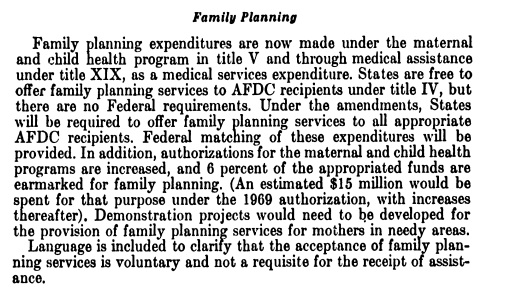In a previous article in this series on the eugenics and class warfare agenda behind federally funded population programs like Title X and others, I detailed how minority leaders quickly became suspicious of the government’s push for “family planning.” This article will document the beginning of this agenda and how suspicions of these programs targeted at “low-income,” impoverished Americans continued.
In 1919, Planned Parenthood founder Margaret Sanger made an astonishing admission. Quoting from Sanger’s “Birth Control and Racial Betterment,” published in the February 1919 edition of her Birth Control Review, Sanger says, “Birth Control will clear the way for eugenics and the elimination of the unfit.” She went on:
Before eugenists and others who are laboring for racial betterment can succeed, they must first clear the way for Birth Control. Like the advocates of Birth Control, the eugenists, for instance, are seeking to assist the race toward the elimination of the unfit. Both are seeking a single end but they lay emphasis upon different methods….
Eugenics without Birth Control seems to us a house builded upon the sands. It is at the mercy of the rising stream of the unfit.
Sanger’s statement could almost be described as prophetic. Fears of the overpopulation of certain people groups were and are common in eugenics circles. By the 1960s, as discussed in part one of this series, fears of overpopulation were again being driven by organizations with ties to eugenics, pushing for federal dollars to reduce the births of the poor.
This was met with resistance in the United States, where there was a growing concern that the push for federally funded population control was motivated by a sinister plot to limit the births of Blacks and other minorities. After all, years of eugenic programs, had already been aimed at sterilizing Black Americans, so why wouldn’t federally funded “family planning” programs also target those populations?
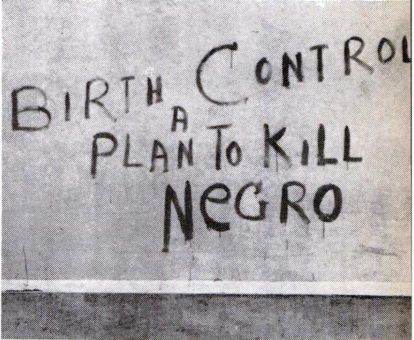
Graffiti says Birth Control is a Plan to Kill Negro (Image credit: Jet Magazine, August 1951)
As Live Action News has previously documented, North Carolina’s eugenics program was funded in part by Clarence Gamble, a member of Planned Parenthood founder Margaret Sanger’s Boards of Directors for both the American Birth Control League (ABCL) as well as Planned Parenthood. He was a close friend of the Planned Parenthood Federation and was also a financier of Sanger’s birth control crusade. That eugenics board was responsible for the sterilization of Elaine Riddick, as seen in the video clip below from the film, Maafa21:
In Margaret Sanger’s “Plan for Peace,” published in the April 1932 edition of her Birth Control Review, the Planned Parenthood founder laid out her eugenic ideas for using government resources to reduce populations of those she deemed “unfit.” It reads in part:
…Second, have Congress set up a special department for the study of population problems and appoint a Parliament of Population, the directors representing the various branches of science this body to direct and control the population through birth rates and immigration, and to direct its distribution over the country according to national needs consistent with taste, fitness and interest of the individuals.
The main objects of the Population Congress would be:
a. to raise the level and increase the general intelligence of population
b. to increase the population slowly by keeping the birth rate at its present level of fifteen per thousand……The second step would be to take an inventory of the secondary group such as illiterates, paupers, unemployables, criminals, prostitutes, dope-fiends, classify them in special departments under government medical protection, and segregate them on farms and open spaces as long as necessary for the strengthening and development of moral conduct.
Having corralled this enormous part of our population and placed it on a basis of health instead of punishment, it is safe to say that fifteen or twenty millions of our population would then be organized into soldiers of defense-defending the unborn against their own disabilities.
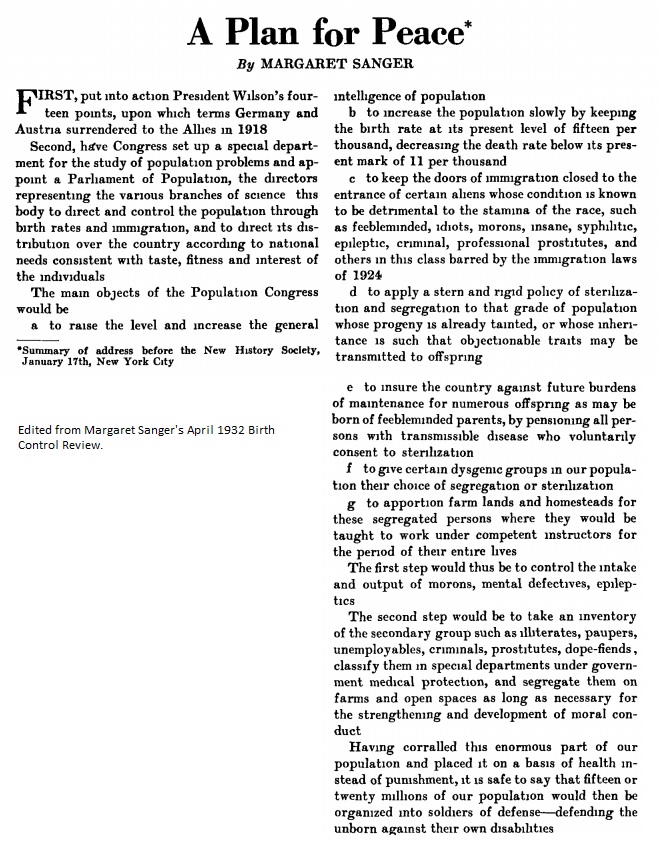
Margaret Sanger’s Plan for Peace (edited)
In 2017, data from the Centers for Disease Control showed that overall, the U.S. birth rate had reached the lowest recorded number of births in 30 years. According to a May 2018 article in Forbes:
… [A]s described… at the Institute for Family Studies, 2017 fertility rates have been published, and show a 40 year low at 1.76 lifetime births per woman, with the most dramatic declines expressed in “missing births” over the past decade, occurring among Hispanic and African-American women, whose fertility rates are now, while still higher, much closer to the already-low rates of white non-Hispanic women. Specifically, the fertility rate for black women dropped from 2.15 to 1.89, and that of Hispanic women dropped from 2.85 to 2.1 in the time period of 2008 – 2016, compared to a decline from 1.95 to 1.72 births per non-Hispanic woman.
Recently, an Urban Institute report which looked at the birth rates for women in their 20s, found that from 2007 to 2012, according to CNBC, “Hispanic women in the age group saw the biggest declines in birth rates—a 26 percent plunge. That was followed by a 14 percent decrease among African-American women and an 11 percent fall for white women.”
Data on users of Title X clinics by race/ethnicity reveal that poor minorities are growing in their usage of the so-called free “family planning” services. In 1991 the Centers for Disease Control (CDC), reported the following:
- 14.9% Hispanic
- 61.9% White
- 17.3% Black
- .5% Native American
- 1.2% Asian/Pacific Islander
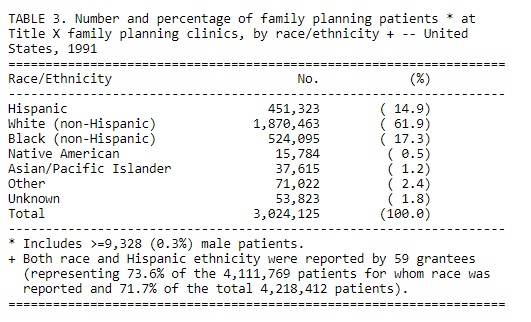
Title X family planning users by race ethnicity 1991 (Image credit: CDC)
Today, according to figures published in the 2016 Family Planning Annual report, those numbers are on the rise. A report published by the blog American Progress states:
- Out of the 4 million family planning clients who Title X serves, more than half are women of color: 30 percent identify as either black or African American, Asian, Native Hawaiian or Pacific Islander, or American Indian or Alaska Native, and another 32 percent of clients identify as Hispanic or Latino.
- 21 percent of all Title X clients identify as black or African American, and 30 percent identify as Hispanic or Latino, while African American people and Hispanic and Latino people make up 13 percent and 17 percent of the U.S. population, respectively.
The figures show an alarming increase in users among the Black and Hispanic communities, specifically. This means that poor, minority women are likely more highly targeted for population control services through federally funded “family planning” programs than in the past.
In 1951, Dr. Charles V. Willie, Professor of Sociology at Syracuse University in New York, noted that Black Americans opposed any government effort to limit their numbers. Professor Willie studied the Black community’s attitudes on this topic and concluded that they viewed these efforts as Black genocide. “The genocidal charge of Black people is anchored in good data,” the professor told Jet Magazine. “Blacks point out that a leading government spokesperson has declared that an increase in Black people of 1 to 2 percent points of the total population is ‘extra-ordinary.’ Blacks also point out that whites were not concerned about their family form and size during the age of slavery.”
Simone M. Caron’s research published by the Journal of Social History, entitled, Birth Control and the Black Community in the 1960’s: Genocide or Power Politics?, gave several examples, including the attitudes of the Black Panther party, writing:
The Black Panther party considered contraception only one part of a larger government scheme of genocide. Drugs, venereal disease, prostitution, coercive sterilization bills, restrictive welfare legislation, inhuman living conditions, “police murders,” rat bites, malnutrition, lead poisoning, frequent fires and accidents in run-down houses, and black over-representation in Vietnam combat forces all contributed to the malicious plan to annihilate the black race.
Author Donald T. Critchlow, in his book, “Intended Consequences, Birth Control, Abortion and the Federal Government in Modern America,” also noted the opposition, writing, “The Black Muslim newspaper, Muhammad Speaks, kept up a steady attack on federal family planning programs as a white plot against the black community.”
By 1962, Urban League and NAACP chapters would join the list of “family planning” critics, according to Caron:
Whitney Young, leader of the Urban League, revoked his group’s support of contraception in 1962. Several local NAACP chapters followed suit. Marvin Davies, head of the Florida NAACP, rejected contraception and argued that black women needed to produce large numbers of babies until the black population comprised 30-35 percent of Americans; only then would blacks be able to affect the power structure.
In September of 1965, according to author David Allyn in his book, “Make Love, not War,” “the NAACP opposed a $91,000 federal grant for the dissemination of birth control information in North Philadelphia. The NAACP charged Planned Parenthood, which had applied for the grant, with attempting to ‘help Negroes commit racial suicide.’ ”
Many of these fears were confirmed when, in 1964, the platform of the American Eugenics Party included the following:
- The United States is already over-populated. We must stop all immigration and impose birth controls.
- Those genetic types within each race and stock having better traits will be encouraged to produce more offspring and those having the lesser qualities will be restricted in the number of their offspring.
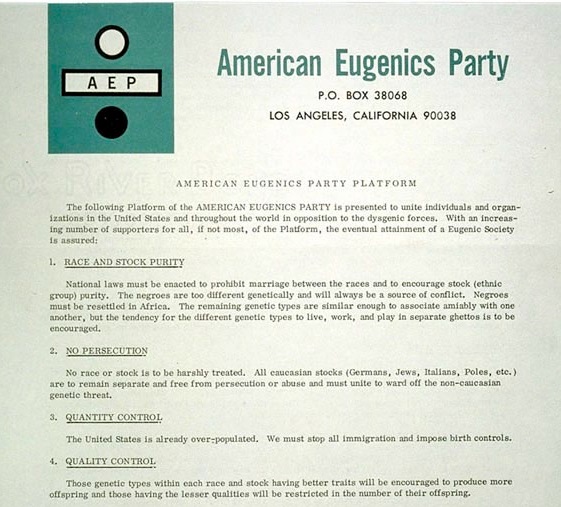
American Eugenics Party platform 1964 (Image credit: DNA Learning Center at Cold Springs Harbor)
But advocacy of “family planning” programs was strong and the push was coming from top leaders, including the President of the United States.
In 1965, President Lyndon Johnson (LBJ) lent his support to taxpayer funded “family planning” efforts within the U.S. and abroad, claiming in a speech that for every five dollars spent on population control, more than a hundred would be invested in economic growth. For implementation of an “affirmative and effective population policy at home and abroad,” President Johnson was bestowed Planned Parenthood’s highest award (the Margaret Sanger Award).
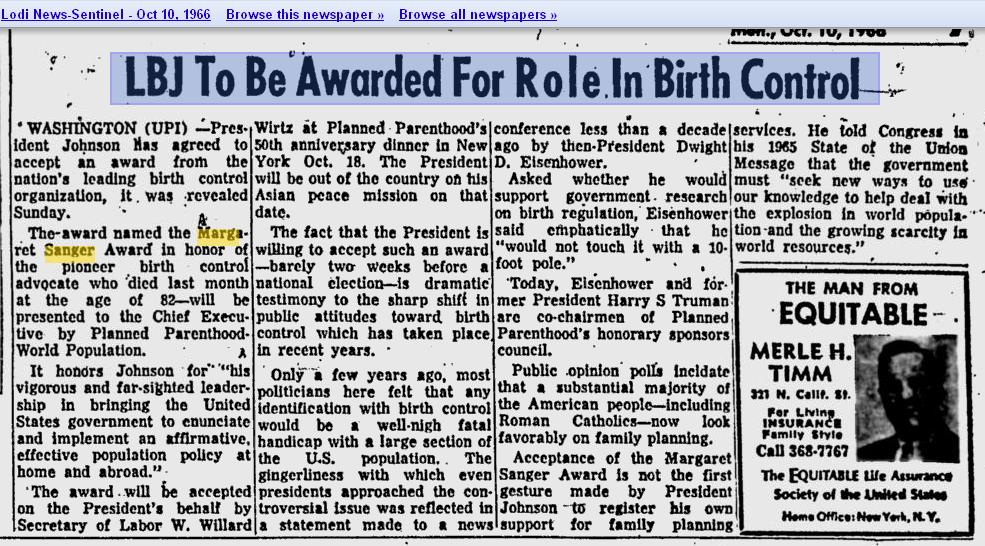
Lyndon B Johnson receives Planned Parenthood’s Margaret Sanger Award
Planned Parenthood had its roots in eugenics; founder Margaret Sanger was a member of the American Eugenics Society, who stacked her board with leaders of the eugenics movement and even willingly spoke to members of the Ku Klux Klan. Simply changing the organization’s name from the American Birth Control League (under Sanger’s leadership) to Planned Parenthood did not erase Planned Parenthood’s eugenics ties. You can trace the organization’s deep ties in eugenics well beyond their name change in 1942, and that philosophy has been carried on throughout its history.
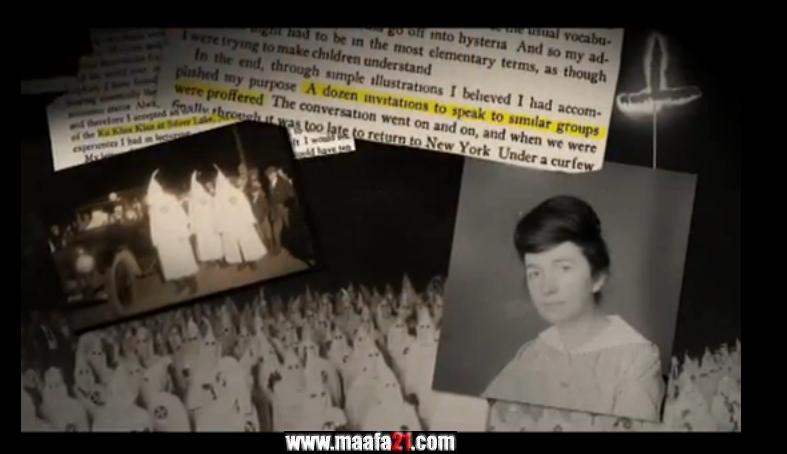
Margaret Sanger writes about Klan meeting in Autobiography (Image credit: Maafa21)
Planned Parenthood‘s medical director during this time (1962) was a doctor by the name of Alan Guttmacher, a former VP for the American Eugenics Society and founder of Planned Parenthood’s research arm and “special affiliate,” the Guttmacher Institute, who later went on to become president of Planned Parenthood.
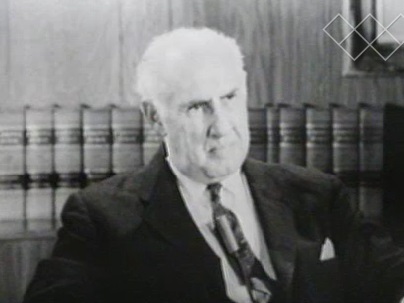
PPFA president Alan F Guttmacher speaks about abortion, 1965
Guttmacher was also a eugenicist, joining others of his day in voicing a concern about rising population growth. Guttmacher did not discount the idea of coercion.
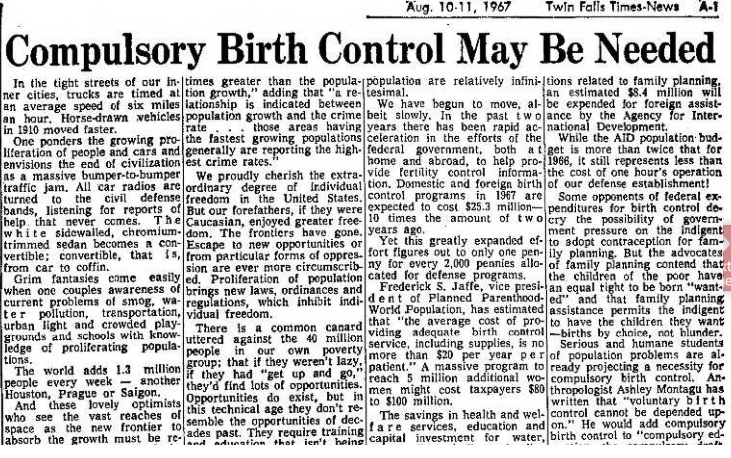
Compulsory Birth Control article
In 1966, Guttmacher compared the world population with the threat of nuclear war, telling the Washington Post that governments may have to act officially to limit families. “It may be taken out of the voluntary category,” Guttmacher said.
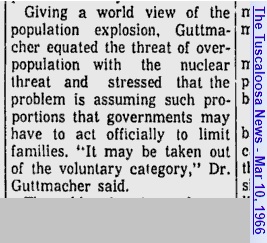
Guttmacher abortion coercion possible
Although Guttmacher can be credited as the mastermind behind the push for abortion at Planned Parenthood, he also helped craft the push for taxpayer funded family planning.
As Live Action News previously documented, in 1966, Guttmacher proposed a blueprint to force taxpayers to pay for birth control access for the poor. By this time, Guttmacher had become more crafty in his messaging, promoting the concept as empowering others to make “choices,” when the real motivation was population control. This eugenics agenda was clear in his statement published by the New York Times: “The main goal of our program is not just to limit population, but to give everyone the same opportunity for quality medical care.”
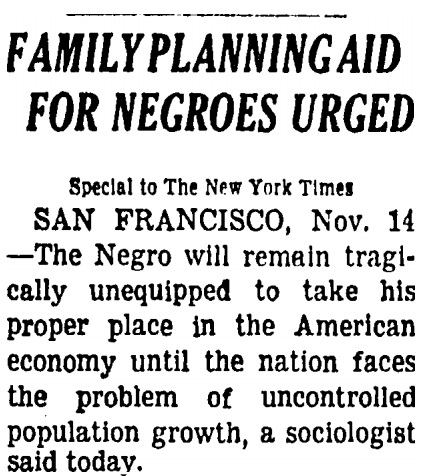
1963 article urges family planning for Blacks (Image credit New York Times)
The “plan” — described by a 1966 New York Times article as a “partnership of public and private agencies” — was to make birth control services “freely available to every American by 1970” in an effort to prevent about 250,000 pregnancies every year. It was presented at Planned Parenthood’s New York headquarters by the organization’s then-president, George N. Lindsay, who called it the “best bargain in health services that money could buy.”
Interestingly, a short time later, in 1967, according to HHS’ Administration for Children and Families website, funds for “family planning” were introduced:
The 1967 Social Security Amendments earmarked 6 percent of maternal and child health funds for family planning, officially sanctioning the Children’s Bureau’s involvement in these services for the first time. By 1968, nearly all States were providing some form of family planning through this program (up from 20 States just 4 years earlier), bringing assistance to more than 420,000 women.
1967 Child Health Program funds Family Planning
According to a Brookings Paper on Economic Activity report:
In addition, the Maternity and Infant Care projects under the Department of Health, Education and Welfare (DHEW) supplemented the EOA [1964 Economic Opportunity Act (EOA)] effort by funding family planning services through city health departments. From fiscal 1967 to fiscal 1970, federal funds allocated to family planning increased to roughly $600 million (in 2010 dollars), over 10 times their level in 1967.
Author Donald T. Critchlow noted in the aforementioned book that by 1967, the “Children’s Bureau budget was increased to $50 million… but the bureau was hamstrung by restrictions that limited matching grants to state and local agencies. This policy deliberately excluded voluntary agencies such as Planned Parenthood from receiving federal funds administered through state and local agencies.”
However, Critchlow also observed that by the time Lyndon B. Johnson left office in 1968, “a policy revolution in federal family planning had occurred, setting the stage for the further expansion of family planning programs under Richard Nixon.”
In part three of this series, Live Action News will detail how the population control movement recruited a Republican president to push this agenda. Additional articles on Title X’s history are included (Parts one, two, and four), as well as Planned Parenthood’s Blueprint and George HW Bush’s relationship to TitleX and Planned Parenthood.
Editor’s Note, 11/8/18: Links to related articles were added.


